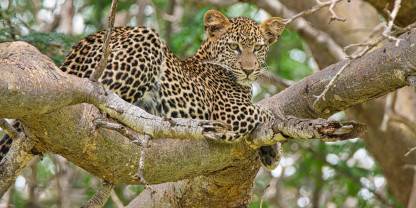Average Expert Rating
Rating Breakdown
Write a User ReviewElephant Splendor in Tsavo East
I’ve always loved Tsavo East National Park’s expansive landscape with its characteristic red soil and dramatic skies. For holidaymakers at the Kenyan coast, it’s the obvious place to go for a quick safari… So, it’s no surprise it can get busy, but luckily the park is vast and getting away from the crowds isn’t too difficult. Just like in Tsavo West National Park, all the animal action tends to be at the water holes. We decided to spend the afternoon at the viewing deck of Voi Safari Lodge to let the wildlife come to us. It was relatively quiet at first, but as dusk arrived so did the elephants. Cuteness overload was provided by the babies splashing around between the adults’ legs and lots of oohing and ahhing was provided by the other guests. Although we might have been a tiny bit jaded at the end of a 6-week safari, a scene like this never gets stale. And sharing it with a bunch of people who had probably never seen an elephant in the wild before is kind of special in its own right.
Kenya’s Largest Wilderness Park
Read more
and rhino sightings in this area. Game drives elsewhere tend to be a bit more hit-and-miss, and wildlife is more skittish.A scenic highlight of Tsavo East is Mudanda Rock. This immense bald outcrop can be summited on a short flight of steps to offer aerial views over a waterhole that often attracts large elephant and buffalo herds. Another area of interest is the palm-fringed Galana River (Kenya’s second largest), which divides the park’s relatively busy southern sector from the little-visited wilderness area to the north. If you visit the river, do stop at the scenic Lugard’s Falls, which you can explore on foot, keeping an eye out for elephants and other wandering wildlife. Nearby Crocodile Point offers a view back to the waterfall and across the river to a sandbank where you're likely to see hippos, crocodiles and water-associated birds such as African skimmer, palmnut vulture and African fish eagle.
Tsavo East is one of my favourite birding sites in East Africa, as it offers the opportunity to see a number of localised dry-country beauties – among them the golden pipit, rosy-patched bush-shrike, northern carmine bee-eater and golden-bellied starling. Overall, Tsavo East may not offer the best game viewing in Kenya, but away from a few tourist hotspots, the sense of untrammeled wilderness more than compensates.
Tsavo East: Home of the Red Elephants
Tsavo East is one of the most visited parks in Kenya, thanks to those on short-haul safaris from Mombasa and the coast, but most restrict themselves to short excursions in the park’s south. To escape the crowds, I like to cross the savannah plains that extend north to the Galana River – lion sightings are possible
Read more
here and the striated rocks of Crocodile Point are extremely pretty. I also love Tsavo for the chance it offers to see gerenuk (which I’ve seen every time) and Beisa oryx, but I still dream of seeing the critically endangered hirola antelope…The Big 5 in a Wide East African Savannah
Read more
off the two or three beaten tracks, and you may find something special – perhaps a serval or lesser kudu.The Land of Red Elephants
Tsavo East is Kenya’s largest big game stronghold and is much bigger than neighbouring Tsavo West, from which it is separated by the Nairobi to Mombasa highway. It is also much drier, an arid wilderness renowned for its herds of red elephants, which acquire their unusual terracotta appearance by wallowing and dust-bathing in Tsavo’s red laterite soil. Tsavo lions are different, too. The males have little or no mane and in my experience tend to be far less relaxed when approached. Maybe they are descendants of the notorious man-eaters who terrorised Tsavo when the railway was being built in the late 19th century? From the veranda of Voi Safari Lodge high up on its rocky ridge you can look out over a vast sweep of the park that includes the Aruba Dam and Kanderi Swamp – both of which attract lots of game. Another dramatic viewpoint is the granite whaleback of Mudanda Rock that overlooks a favourite watering hole for elephants. And be sure to include a stop at Lugard Falls where the Galana River rushes over a series of foaming rapids.
The Largest Half of Kenya’s Biggest Wildlife Reserve
At more than half the size of Wales, Tsavo East is even larger than its sprawling neighbour, Tsavo West. But while the latter is dominated by hilly country, Tsavo East is mainly made up of dry, scrubby plains. In the dry season, there are huge herds to admire: the animals, which include elephant and giraffe, rarely stray too far from the waterholes or the wooded banks of the Voi and Galana Rivers, where most of Tsavo East’s thinly scattered lodges are found. To me, the Galana riverbanks are the most attractive part of the park, particularly their dense stands of palm trees and the time-worn rocks of Lugard Falls.

